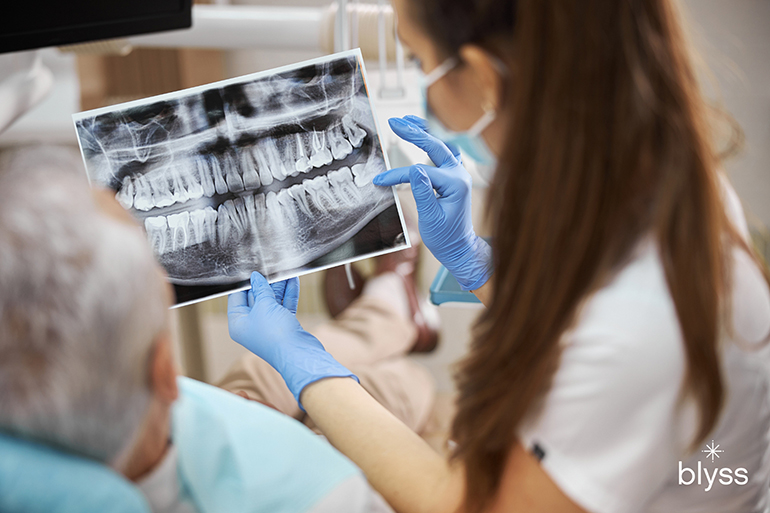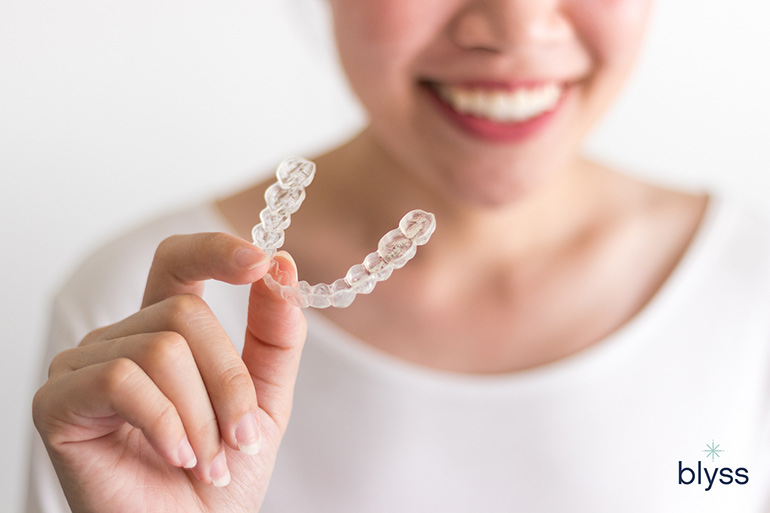Is getting a dental implant painful? This is one of the first questions that crosses the minds of many who are considering dental implants.
The truth is, many people hesitate to get this treatment even though they can benefit from it because they don’t want to experience pain. While no one enjoys pain, it’s important to be informed and understand what kind of experience you can expect during and after dental implant surgery.
As a dentist, I understand these fears and concerns.
Dental implants may sound intimidating, but the truth is that with modern anesthetic techniques and state-of-the-art technology, most people experience very little pain during the procedure.
In fact, in many cases, the recovery process can be surprisingly manageable, making dental implants an excellent choice for restoring a healthy smile free of embarrassing gaps or missing teeth.
So let’s delve into some key facts that can help remove any anxiety you may have about dental implant surgery. As a dentist who routinely places implants, I have seen these facts play out time and time again.
Does Dental Implant Surgery Hurt?
As with any surgical procedure, there will likely be some degree of discomfort when getting a dental implant. But you shouldn’t feel pain because the procedure is performed under anesthesia.
Local anesthesia or conscious sedation is typically administered during implant surgery. IV sedation or general anesthesia are options for more complex cases such as full-mouth extractions and dental implants. However, administering it often requires an anesthesiologist to visit the dental office.
It’s important to note that every person has their own unique level of pain tolerance, and this can play an important role in how you feel during and after your dental implant placement.
Dental Implant Tip: Consult with your dentist ahead of time. This ensures that you receive optimal care throughout all stages of the process while minimizing feelings of apprehension or anxiety related to having a dental implant placed.
3 Dental Implant Facts That May Surprise You
With modern advances in technology and anesthetic techniques, the procedure to get dental implants is safer and more comfortable than ever before. While many people know about the basic facts surrounding dental implants, there are some details that may surprise you.
Here are some facts that I share with my patients to ease their fears about getting dental implants.
Fact #1: Advanced Anesthetic Techniques Minimize Pain and Discomfort
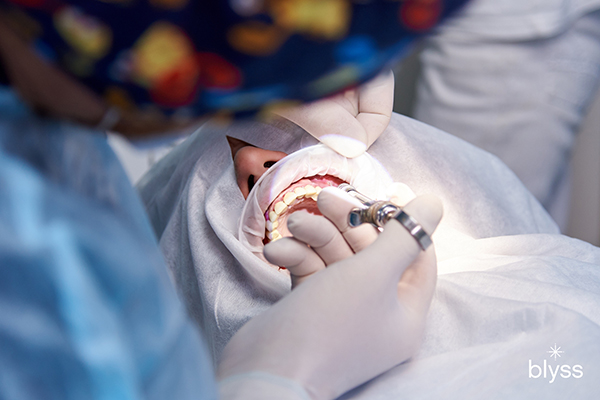
Anesthetics play an important role in dental implant surgery as they help ensure that your experience remains comfortable and pain-free from start to finish.
As a dentist, one of my top priorities is the comfort of my patients. That’s why administering anesthesia prior to dental surgery is a must.
Today’s anesthetic techniques are far more advanced than in years past. In fact, these advances make it virtually painless for patients. Generally, there are three types of anesthesia that are used for dental implant surgery.
These are:
- Local Anesthesia – You are fully conscious, but you will not feel pain during the surgery with this type of anesthesia. It only numbs the implant site.
- Oral Sedation – It is taken in pill form about an hour before the surgery. It is designed to make you feel deeply relaxed and sleepy, although still conscious. If you opt for this type of anesthesia, please arrange for someone to drive your home after your appointment.
- IV Sedation With Local Anesthesia – This is also known as twilight sedation. It combines the effects of local anesthesia with a sedative to put you into a light stage of sleep, leaving you largely unaware of the procedure being performed.
- General Anesthesia – This type of anesthesia allows your doctor to anesthetize your entire body. This means you are fully unconscious during the whole operation.
Fact #2: Modern 3D GuidedTechnology Reduces Your Discomfort
The traditional technique to place dental implants is to open the gums and install the titanium post into your jawbone using free-hand techniques. It involves estimating the best position and angulation of the dental implants. The dentist will close the site with stitches after the implant is installed. This method is often more invasive and requires a longer recovery time.
Modern surgery technology for dental implant placements reduces your overall discomfort. It also makes the surgery more accurate.
At Blyss Dental, one of the modern techniques I use is an approach called 3D-guided surgery.
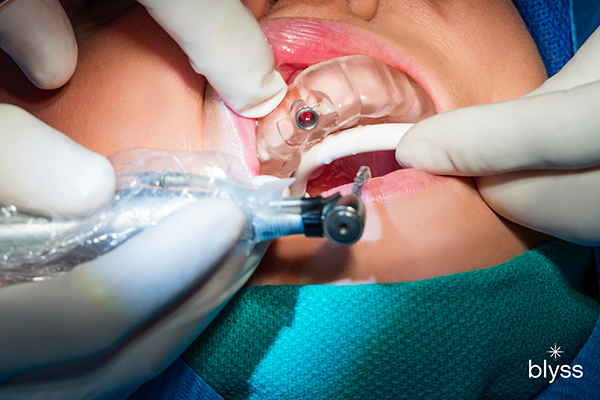
All things considered, 3D guided surgery is a great solution for helping me accurately place your dental implants without having to expose a larger area of gum tissue than necessary during surgery.
What is 3D-guided surgery for implant placement?
This is a computer-assisted imaging procedure that helps me plan your implant placement with less room for error. It helps me identify the area where I will place your new implants and crown.
Using advanced technology, I generate a CBCT and 3D scan of your mouth that allows me to create a customized surgical guide made just for you. This guide acts as a template during the actual procedure and helps me accurately place the implants in an ideal location. It also reduces any chances of implant placement errors, as it allows me to insert the implants away from vital nerves and blood vessels and in an area with ample bone.
Benefits of 3D Guided Surgery
Using this technique has several advantages for both you and myself
- The entire procedure is less invasive since I do not need to surgically expose a large area of gum tissue. This greatly reduces discomfort during and after the surgery.
- You will also have fewer stitches, which equates to a faster recovery with minimal postoperative pain or swelling.
- By reducing any chances of implant placement errors, we can ensure your long-term success rate is high with no complications whatsoever down the road.
Dental Implant Tip: Ask your dentist if they do 3D-guided surgery for implant placement. It is a great way to ensure that your implant placement is accurate, comfortable, and stress-free.
Fact #3: Follow Postoperative Care Instructions to Ensure Your Successful Recovery
Swelling and bruising in the area around your implant are common post-surgery side effects that can cause some discomfort. Additionally, headaches or facial pain may occur after a dental implant procedure. This is due to the inflammation in certain areas of your face or jawbone.
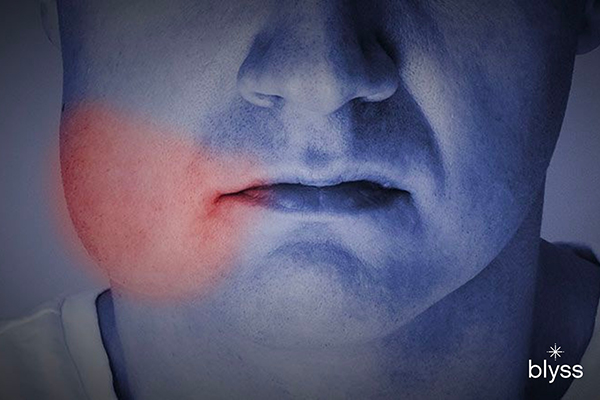
It is normal for patients to experience some level of discomfort after a dental implant procedure. However, this discomfort should not last longer than a few days if managed properly with rest and by following all postoperative care instructions given by your dentist.
However, these symptoms should dissipate over time with proper rest and by following the postoperative care instructions your dentist gives you after the procedure.
Controlling or Managing the Pain Associated with Dental Implants
Pain management becomes our utmost priority in the first 3–5 days after surgery. Dental implants can take anywhere from a few days to several weeks to recover, depending on the complexity of the treatment.
Most patients feel back to normal within three days to a week post-op. After two weeks, most patients have fully recovered with minimal tenderness when touching the implant site.
Meanwhile, a recovery time of up to three weeks is expected for procedures involving tooth extraction and bone grafting.
Some discomfort after dental implant surgery is normal and expected, but severe pain should never occur or persist longer than expected. Talk to your dentist if any unexpected pain arises post-procedure.
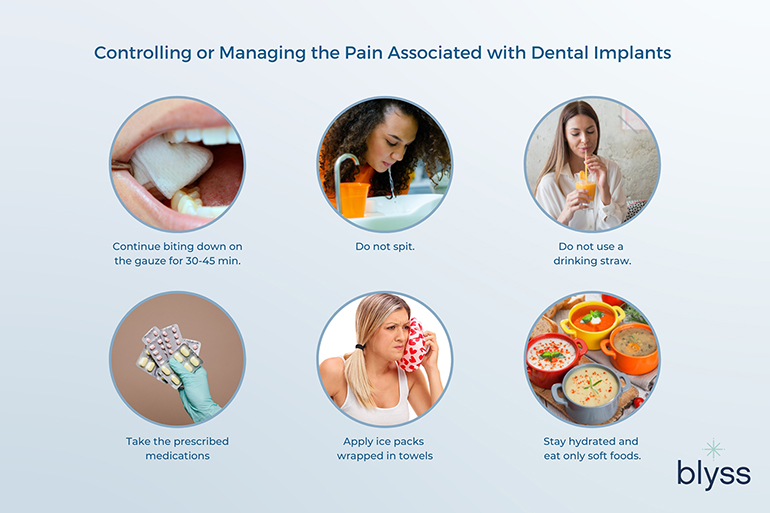
It’s important to know how to best care for your dental implant during its healing process in order to prevent additional discomfort and setbacks in recovery.
Here are some of my postoperative care tips for reducing pain and discomfort:
Immediately After Surgery
- Immediately after the surgery, continue biting down on the gauze the dentist gave you for 30-45 minutes, and replace it as necessary until any bleeding stops. Always use fresh gauze.
- Do not spit, and do not use a drinking straw. Spitting, the use of a straw, and poking the surgical area can dislodge the blood clot that is forming, which can cause bleeding and delay healing.
- Take the prescribed medications exactly as directed. This will help reduce any inflammation at the implant sites and also minimize the risk of infection. Do not take your medication on an empty stomach.
- Apply ice packs wrapped in towels around on your face/cheek adjacent to the surgical site for the first 48 hours on a 20-minute-on/ 20-minute-off schedule throughout the day. This helps reduce swelling and pain significantly.
- After 48 hours of icing, switch to a warm compress (moist warm towels, heating pads) three times per day.
After the Surgery
- Do not smoke/vape after the surgery.
- Stay hydrated. Drink lots of fluids such as water but avoid ‘harder’ drinks like coffee/ alcohol/ carbonated beverages, etc. Dehydration can cause additional swelling, which increases the likelihood of pain.
- Stick only to cold soft foods which you don’t have to chew for the first 1-3 days such as mashed potatoes, pasta, cottage cheese, soup, or scrambled eggs as soon as the local anesthetic wears off. It is important not to put too much pressure on the area around the implant when eating, as this may cause trauma and increased discomfort.
- Avoid strenuous physical activity for the first 7-10 days after surgery(including heavy lifting, intense cardio, contact sports, swimming, surfing, etc.)
- The day after your surgery, you may begin rinsing with a warm saltwater solution (1 tsp of salt in 8 ounces) but be sure to do so lightly and carefully. Use gentle strokes when brushing your teeth with a soft-bristled toothbrush while taking extra precautions near the surgical areas.
Lastly, remember to maintain good oral hygiene practices after surgery. This is essential to ensuring that bacteria do not build up and interfere with dental implant healing.
Final Takeaways
No one wants to go through dental implant surgery if it’s going to be painful and uncomfortable. Fortunately, advancements in techniques and materials have made the entire process far less painful than it once was.
Many patients are now able to undergo the procedure with minimal discomfort and end up with a natural-looking smile that lasts for years.
It’s important to remember that each case is unique. There can be health-related concerns that should always be discussed with your dentist before having any sort of procedure done.
If you are ready to take the next step towards restoring your oral health and improving your smile, schedule a free consultation with Blyss Dental.
Feel confident knowing that you are receiving the best possible care when it comes to your dental needs!
Sources Cited From
- University of Washington School of Dentistry. (n.d.). After Your Oral Surgery. dental.washington.edu. Retrieved January 20, 2023, from https://dental.washington.edu/
wp-content/ media/ oral-surgery/ Afteryouroralsurgery.pdf - Gupta R, Gupta N, Weber, DDS KK. Dental Implants. [Updated 2022 Aug 8]. In: StatPearls [Internet]. Treasure Island (FL): StatPearls Publishing; 2022 Jan-. Available from: https://www.ncbi.nlm.nih.gov/
books/ NBK470448/ - University of Washington School of Dentistry. (n.d.). After Your Oral Surgery. dental.washington.edu. Retrieved January 20, 2023, from https://dental.washington.edu/
wp-content/ media/ oral-surgery/ Afteryouroralsurgery.pdf - Canadian Dental Association. (n.d.). 2015. https://www.cda-adc.ca/
en/ oral_health/ talk/ procedures/ oral_surgery/ - NeigerDesign. (2021b, March 8). What are dental implants? The Dental Implant Experts. https://www.aaid-implant.org/
faqs/ what-are-dental-implants/ - Mistry A, Ucer C, Thompson JD, Khan RS, Karahmet E, Sher F. 3D Guided Dental Implant Placement: Impact on Surgical Accuracy and Collateral Damage to the Inferior Alveolar Nerve. Dent J (Basel). 2021 Sep 2;9(9):99. doi: 10.3390/dj9090099. PMID: 34562973; PMCID: PMC8470513.
- Kapur A, Kapur V. Conscious Sedation in Dentistry. Ann Maxillofac Surg. 2018 Jul-Dec;8(2):320-323. doi: 10.4103/ams.ams_191_18. PMID: 30693254; PMCID: PMC6327823.
